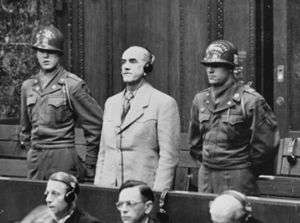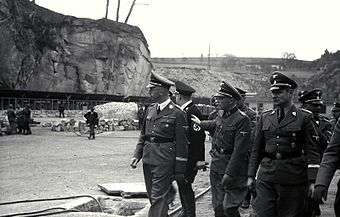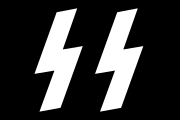Deutsche Wirtschaftsbetriebe
| Deutsche Wirtschaftsbetriebe | |
|---|---|
|
| |
| Location | German-occupied Europe, forced labour |
| Period | World War II (1939–1945) |
Deutsche Wirtschaftsbetriebe (German: for 'German Economic Enterprises') abbreviated DWB, was a Nazi German project launched in World War II by the Allgemeine SS to profit from the use of forced and compulsory labour extracted from the Nazi concentration camp inmates.
Holding company for Nazi German industries
DWB was a holding company for more than 25 SS industries. Oswald Pohl, the head of the SS business department (known by its German initials as WVHA) was also the chief officer of DWB. Georg Lörner, another high WVHA official, was another incorporator.[2] Through stock ownership DWB controlled a wide variety of enterprises, such as stone quarries, brick manufacturing plants, cement mills, pharmaceutical factories, real estate, housing, building materials, book printing and binding, porcelain and ceramics, mineral water and fruit juices, furniture, foodstuffs, and textiles and leather.[3]
Role in war crimes


After World War II. the surviving chief officers of WVHA were placed on trial for crimes against humanity. Most of them were found guilty. Both Oswald Pohl and Georg Lörner were sentenced to death by hanging, although Georg Lörner managed to get his sentence commuted to a prison term. The war crimes tribunal placed particular emphasis on the role the defendants had played in four DWB subsidiaries:
- The German Earth And Stone Works (Deutsche Erd- und Steinwerke), known as DEST, which operated five granite quarries, six brick and tile plants, and a stone-cutting plant;
- The Klinker-Zement, manufacturing brick and cinder block, fireproof products, ceramics, lime, and chalk. This company had large subsidiaries at Golleschau, Prague, Lvov, and Białystok;
- Ostindustrie, or OSTI, organized in March 1943 and dissolved a year later, which, using forced Jewish labor operated all confiscated Jewish industries in German-occupied Poland, including foundries, textile plants, quarries, glass works, and others.
- The German Equipment works (Deutsche Ausrüstungswerke) or DAW, which operated various industries in seven concentration camps, using forced inmate labor.[3]
DEST in particular became notorious for exploitation under brutal conditions of the labor of concentration camp inmates at Mauthausen-Gusen concentration camp in Austria.
Notes
- ↑ "List of 2,500 firms that employed forced labourers" (in German). New Germany. 16 November 1999. Archived from the original on July 19, 2011 – via Internet Archive.
- ↑ Nuremberg Military Tribunal, "Judgment of the Tribunal (regarding Georg Lörner), 3 November 1947", United States of America v. Oswald Pohl, et al. (Case No. 4, the "Pohl Trial), V, pp. 1004–1008
- 1 2 Nuremberg Military Tribunal, "Judgment of the Tribunal, 3 November 1947,", United States of America v. Oswald Pohl, et al. (Case No. 4, the "Pohl Trial), V, p. 962
See also
| Wikimedia Commons has media related to Forced labour in the Third Reich. |
Further reading
- Nicosia, Francis R., and Huener, Jonathan, Business and Industry in Nazi Germany, University of Vermont Center for Holocaust Studies Berghahn Books, 2004 ISBN 1-57181-654-2
- Sofsky, Wolfgang, The order of terror : the concentration camp, Princeton University Press, 1996 ISBN 0-691-04354-X

